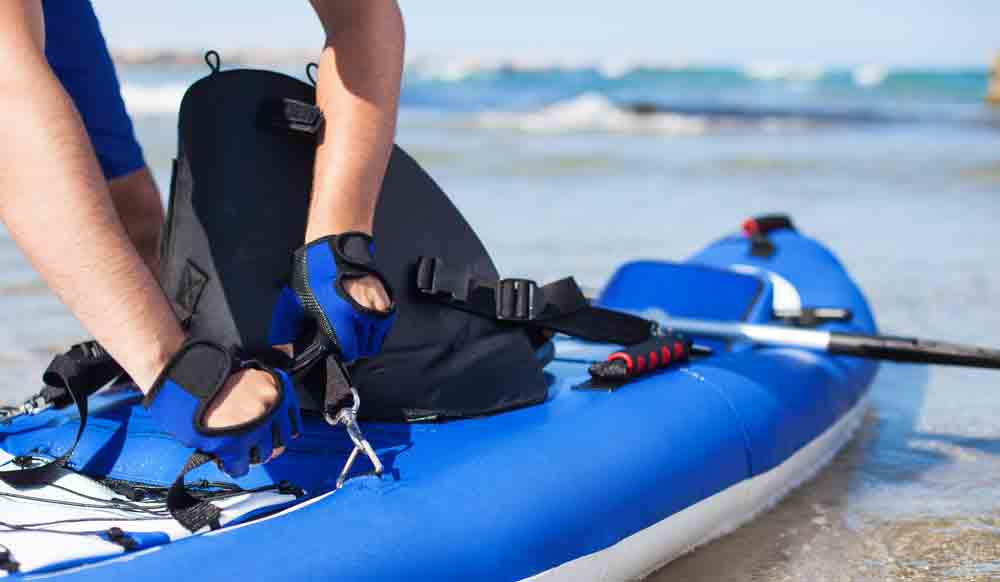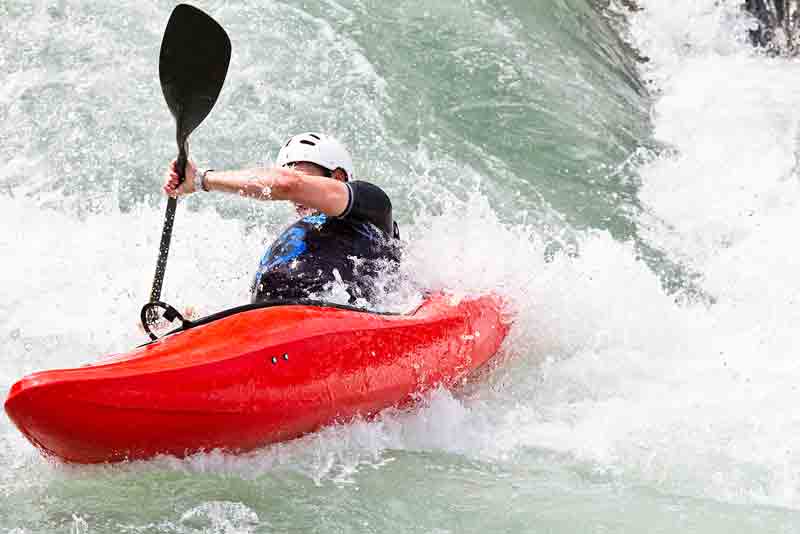The hardshell vs inflatable kayaks can be difficult to discern for someone who has never used both types of kayaks. However, it is an essential distinction for water sports since each boat class offers its advantages depending on the activity at hand. Generally speaking, they tend to be safer than most other boats and allow you to explore many different bodies of water that might otherwise be unreachable by most seafarers.
What Are Kayaks Made Of?
Kayaks are usually made from either fiberglass, plastic, or wood. However, some kayaks are also made from Kevlar or Carbon Fiber which is a very strong lightweight material. Read on to find out the differences between each type.
Fiberglass Kayaks – Fiberglass kayaks have been around for decades and are still being manufactured all over the world. Fiberglass is a material made from layers of glass and resin which are fused together under heat and pressure. The manufacturing process gives the kayak its unique properties such as being both flexible and durable.
Fiberglass kayaks offer a very rigid finish that is also light in weight but requires more physical energy to maneuver. Fiberglass kayaks are also very durable and can last for years. It is the best material for kayaks used in rough waters, frequently exposed to abrasions, small stones, or large waves.
Plastic Kayaks – Plastic kayaks are manufactured using thermoplastic polyurethane compounds which gives them a hard smooth finish that is both light and durable. A rigid kayak also has a very small fabricating price tag than fiberglass kayaks.
The downside to using plastic in making kayaks is the durability of the material which only lasts for half as long as fiberglass kayaks do, and may break with impact or stress if not used properly. However, plastic kayaks are still a great alternative for people who want to try out kayaking without spending too much money.
Wood Kayaks – Wooden kayaks are manufactured via traditional boat-building techniques which also makes them more expensive compared to other types of kayak materials. However, if properly taken care of, wooden kayaks may last even longer than fiberglass and plastic kayaks.
Kevlar Kayaks – Kevlar kayaks is a lightweight material that’s five to six times stronger than steel with an equal amount of weight, and only half the density of fiberglass. However, Kevlar is more expensive compared to other types of kayak materials and not as durable materials as Fiberglass kayaks.
Carbon Fiber Kayaks – Carbon fiber kayaks are more expensive than Kevlar kayaks and also less durable. However, carbon fiber is the most lightweight of the three which requires lesser physical energy to maneuver. It’s also highly resistant to dents and impact but has a shorter lifespan than fiberglass and plastic materials do.
Inflatable Kayaks – Inflatable kayaks are basically made from the same material that’s used to make inflatable rafts. The difference is that they can be stored in a small space, unlike fiberglass and wooden kayaks which need ample storage room for them to be kept.
Paddleboards – Paddleboards are manufactured using the same method used in making surfboards which involves covering material in resin and fiberglass.
Carbon Fiber, Kevlar, and Carbon Fiber kayaks are the most expensive type but offer more advantages compared to other types of kayak materials. If you’re just starting out and don’t want to spend too much money on your first kayak purchase, then plastic or inflatable kayaks will be a good choice.

Which More Expensive?
Inflatable kayaks are becoming more popular compared to fiberglass and plastic kayaks. However, inflatable kayaks have been criticized for being less durable than hardshell designs.
The downside of using an inflatable kayak is that it’s prone to punctures or tears if not maintained properly. On the other hand, a good-quality hard shell kayak can last for years without modifications or repairs.
The pros of using an inflatable kayak are that it’s lightweight, durable, easy to assemble and disassemble, won’t take much storage space in the garage, is safe for family use, and can be used by beginners.
A hardshell kayak offers better speed for long-distance travel while giving you the option to use a rudder for added maneuverability. A hardshell kayak is also more suited for rough waters or adventure tours and offers better storage options than inflatable kayaks.

Transportation and Storage
most inflatable kayaks are the most portable type of kayak as they’re lightweight and easy to store. They can be deflated and folded up into a small bundle that you can carry around with ease.
On the other hand, hardshell kayaks offer superior weight capacity compared to inflatable kayak designs, an added advantage if you want to take your kayak with you on an adventure tour or camping trip.
A hardshell kayak may be bulky and difficult to maneuver in tight spaces but can withstand impact even when loaded up with gear which gives it an advantage over inflatable kayaks during transportation.
Safety in the Water?
Inflatable kayaks are the safest type of kayak. They’re more stable and can handle bigger waves without tipping over easily as hardshell designs, making them ideal for family use as well as beginner kayakers.
Hardshell boats on the other hand may be safer in deeper waters but are more likely to capsize when used for whitewater kayaking. If you’re looking for a beginner kayak that’s suitable for use in rivers and streams, then an inflatable or hardshell boat would be a good choice.
Which is Faster?
Hardshell kayaks are faster than inflatable boats due to their superior hull designs. However, an inflatable kayak with a larger size may be able to keep up with hardshell designs in terms of speed.
Which is More Comfortable?
An inflatable kayak is less comfortable compared to a hardshell design as they have a lower weight capacity and may not be as stable as a hardshell kayak. Inflatable designs are also more likely to roll over if the wind picks up or you try paddling at full speed.
Which is Easier?
An inflatable kayak is easier to carry around than a hardshell kayak. However, assembling an inflatable boat may take some time compared to the faster setup of a hardshell design.
Which is Better for River Running?
Inflatable kayaks are the best option for river running as they can handle rough waters better than hardshell designs. Hardshell boats may be able to keep up speed-wise, but inflatable kayaks have a more stable hull so you’ll have an easier time paddling without rolling over.
Which is Better for Fishing?
An inflatable kayak is better if you’re looking for a kayak to go fishing with. It has more storage space compared to hardshell designs which give you added room for gear and accessories. You can also use a fishing kayak as a flotation device if you end up capsizing since it can support your weight.
Which is Better for Adventure Trips?
Hardshell kayaks are ideal for adventure trips as they’re more durable and have superior storage space compared to inflatable designs. You may want an inflatable boat for a short tour or if you need a kayak that you can carry around, but a hardshell design is better suited for long paddling sessions.
Which is Better in the Ocean?
In general, neither an inflatable nor hardshell kayak would be better in the ocean as both designs have their advantages and disadvantages. However, a hardshell kayak may be a safer choice since it has superior hull designs that can handle high waves.
Which is Better for Fly Fishing?
Inflatable kayaks are easier to use than hard-shell kayaks when flying fishing due to the lack of storage space and inflatable seats. Hardshell kayaks are also likely to capsize if you’re fishing in rough waters since they have narrow, flat hulls that don’t handle waves well.
How Much Can You Carry?
Inflatable kayaks can carry as much as a hardshell kayak, although the total weight capacity of an inflatable boat is usually lower. Hardshell designs have wider hulls so they can take on more cargo compared to inflatable kayaks which may have stability issues once you load it with heavy items.
Can You Take It In the Car?
Inflatable kayaks can be rolled up and easily transported in a car trunk while hardshell kayaks have fixed parts that have to be assembled before you can take them out. However, hardshell kayaks are easier to load on top of a vehicle since inflatable kayaks are usually bulkier.
What Type of Water Can You Take It In?
Both inflatable and hardshell designs can be used in flat water, although an inflatable kayak is the better choice when it comes to rough seas. A hardshell kayak may be better for flatwater use since it has a long, slender shape that slices through the water.
What Type of Kayaking Will You Be Doing?
Hardshell kayaks are more intended for touring while inflatable designs make great recreational kayaks. If you need a kayak for river running, inflatable kayaks are the better choice since they handle rough water well. Hardshell kayaks tend to be faster but may not be as stable in choppy seas.
Do You Have to Pump It Up?
Inflatable kayaks require more time and effort when it comes to setting up compared to hardshell designs which can be paddled immediately. However, inflatable kayaks may take less time since the air pressure of the boat is already set up when you receive it.
Is It Easier to Store?
While both designs require some amount of storage, an inflatable kayak may be easier to store since you can simply roll it up and put it in the trunk of your car. You may have to disassemble a hardshell kayak before you can store it.
Difference Between Inflatable And Hardshell Kayaks
The main difference between inflatable and hard shell kayaks is how they function when they are not actively paddled around. While a hard shell will always remain rigid until deflated or physically broken, an inflatable can take up water if it takes too much of a beating. In this way, an inflatable boat is more sensitive to the effects of waves and tends to be less stable when it is in motion, although the proper technique can eliminate that tendency.
Despite their different construction materials, inflatable and hardshell kayaks tend to have similar price tags. This makes them both accessible since they usually do not require a significant financial investment to get started. However, once you learn to use it properly, an inflatable kayak offers many advantages over its rigid counterpart. For example, most people find it easy to get one onto or off of their vehicle compared with something like a traditional canoe which may involve taking the car apart piece by piece just for transport alone. Additionally, inflatable kayaks are less likely to be damaged by rocks or other obstacles on the beach, whereas a hardshell might sustain some damage.
Inflatable Kayak Vs Hardshell Kayak

